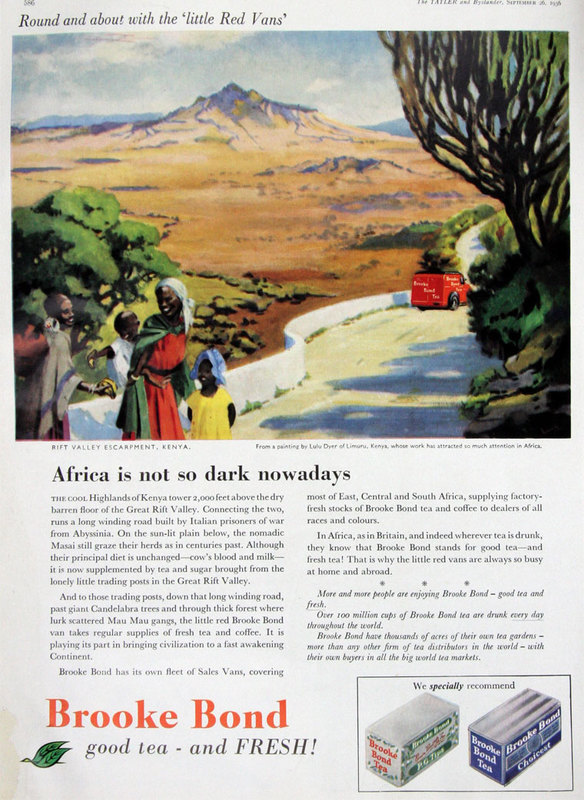Tea Production in "Africa" under British Rule
This a painting created by Lulu, a British settler in Kenya in 1950s. Brooke Bond tea company used the painting for advertisement, pointing out how civilized ‘Africa’ had become, and was producing good and fresh tea. The painting was also featured in The London Times, and it company intended to reach out to many British tea drinkers, and create an image of Kenya that was attractive and exotic. Interestingly, the advert also mentions how the local people (the Maasai), had changed their diet (mainly cow's blood and milk), and they had started supplementing it with tea and sugar.
Interestingly, Brooke Bond simply labeled Kenya as "Africa" even though the advert appeared in 1956 ignoring the fact that there were many other African countries not producing tea at the time; the presents of raw materials in many African countries might have influenced the company to make that claim intentionally. 36 years earlier, the British Empire had declared Kenya a Colony (1920), ruling it until 1963 when Kenya attained its independence. As a new colony, Kenya was not one of the preferred Africa’s countries for British expatriates to move to. In order to entice its citizens to move to Kenya, the British government had to use advertisements in its newspapers, detailing how Kenya had favorable climatic conditions and arable land. In a similar way, Caroline powerfully explains that in such advertisements, the British government explained: “Settle in Kenya, Britain’s youngest and most attractive colony. Low process at present for fertile areas. No richer soil in the British Empire. Kenya Colony makes practical appeal to the intending settler with some capital. Its valuable crops yield, due to the high fertility of the soil, adequate rainfall and abundant sunshine. Secure the advantage of native labour to supplement your own effort (Caroline, 2005). In keeping its promise, the British colonial government allocated fertile land to its new settler, the same land that had been confiscated from the locals.
As a new British colony, the colonial government of Kenya used a strategy of indirect rule structure. The local chiefs and other ‘leaders’ benefitted from this strategy at the expense of the locals (Miller, 1984). As a reward for their collaboration, some chiefs were also awarded with title deeds and were able to access foreign tea markets (Brett, 1973).
According to Leys, a political economy of development scholar, the land areas were also divided into two regions: the white highlands and the reserves. This was done intentionally in order deprive the natives of access to capital, roads and well-paying crops (Leys, 1975). In doing so, the locals had no choice but to work at the plantations.
With the increased demand for arable land owing to tea production and other cash crops such as coffee, British settlers in Kenya drastically changed land rights. In this case, the European concept of private ownership of property complicated the local’s land tenure structures, permitting simultaneous user rights both to previous and incumbent owners (Ibid,. p, 175). In other words, as Gavin (1980) explains, “to own presupposed that there were others who do did not own” (Gavin, p.2). The long-standing role of ethnic communities in distributing and subdividing land based on the clan was periodically done by the leaders of lineages mostly allocated to household heads depending on the magnitude of their needs, but British land politics changed this drastically and without ethnic leaders input (Bates, 1981)
Indeed, the British government helped its citizens to relocate to Kenya and close to 4 decades later, the Brooke Bond company had acquired thousands of arable lands and its advertisements in the London Times confirms that they were trying to expand their markets and reaching out to more British consumers in Britain.

